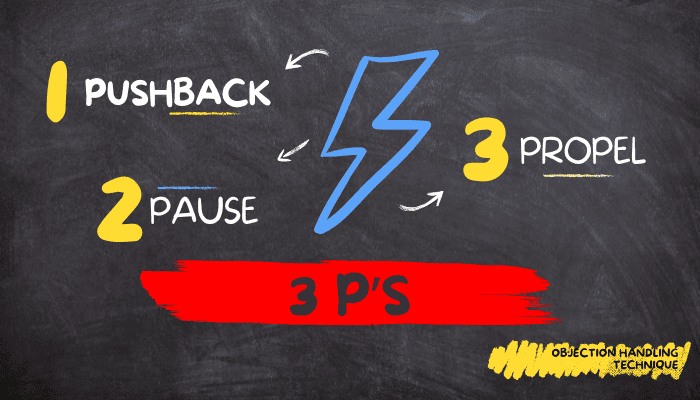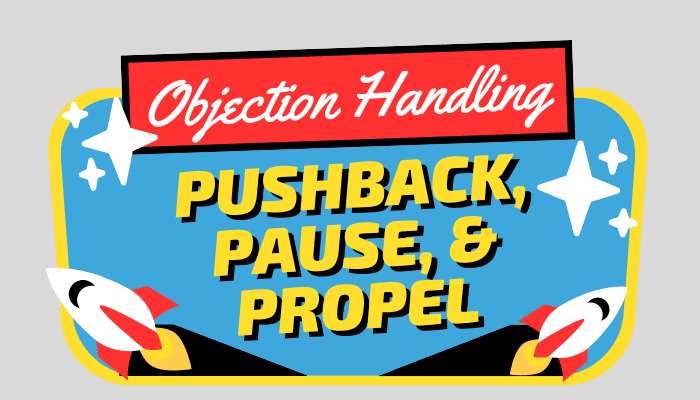Are you looking to master a fresh objection handling technique to overcome challenges in sales?
Have you tried different approaches to overcoming objections and just found that you are not seeing the impact that you’d like?
Whether you are new to sales or you’ve been in sales for some time, objections are a normal part of the process.
Some of the objection training that’s out there, the tips or strategies, they’re not always effective, especially with today’s buyers who are a lot more complex, right? They’ve done their research and they’re very fixated on what else is in the market, which can make things a lot more difficult.
So a strategy to overcome objections that was working 15 years ago may not be so effective in today’s environment. Fortunately, there is an effective strategy that works with all sorts of sales professionals and sales leaders around the world.
I call it the Pushback, Pause, and Propel method to overcome objections, and that’s what we’re going to go through in this video.
Mindset: What is a Sales Objection, Really?
Let’s start with mindset. When it comes to objections, we can often be a little bit taken back, right? Somebody shares an objection that you may not expect and you go, oh, oh, wow, I thought we were doing well here and suddenly we’re not, right?
(1:43)
So objections can play a little bit of a mind game with sales professionals.
Now, if you’ve been around for a while, you’ve been selling what you’ve been selling for some time, you’ve probably heard most of the objections that are out there, but they can still throw us off.
So step one is mindset. Realize that an objection, presuming the buyer is still on the phone or they’re still in the zoom meeting or they haven’t left the room, they’re still interested.
- So an objection is not really a, “Hey, get out. I want nothing to do with you.”
- It’s more a matter of saying, “I’ve got a question, or I’ve got a concern, or something has come up. I need you to explain or help me understand why that’s not an issue.”
 That’s really what an objection is. Once you realize that we can tend to calm down, which means we’re in a better state of mind when it comes to dealing with objections, which is the fundamental, the foundation to being able to use the pushback, pause, and propel method.
That’s really what an objection is. Once you realize that we can tend to calm down, which means we’re in a better state of mind when it comes to dealing with objections, which is the fundamental, the foundation to being able to use the pushback, pause, and propel method.
(2:34)
So step one, mindset. An objection is simply “Hey, help me understand this question, this issue, this concern that I have.” That’s all it is.
Don’t panic, stay in it. Let’s keep going.
The 3-P Method of Objection Handling
 So then here is the Pushback, Pause, and Propel objection handling technique to dealing with objections.
So then here is the Pushback, Pause, and Propel objection handling technique to dealing with objections.
Pushback is simply taking the objection that was shared with you and pushing back a bit on it, challenging the buyer bit, not offending them, not being insulting. (You’re not going to stand up and pound your fist on the table.)You’re just going to push back a bit on what they say, and you’re going to Pause. You want to look for a reaction from them because that’s going to tell you which way to go next.
The Propel is using a transitional statement that moves the conversation back in the direction you want it to go.
Examples of the 3P’s Objection Handling Technique
Let me give you some examples of this objection handling technique in action.
Example 1: Handling a Price Objection
(3:24)
Let’s suppose you’re trying to sell a piece of equipment and it’s expensive. You’ve got a pretty high price here and you’ve got good justification for that higher price, good quality. You’ve been around a while, whatever the case might be.
So your buyer says to some point during your conversations, presuming these aren’t early, but they’re may be later in the conversation, they say, “You know what? Unfortunately, the cost of your equipment is just too high. I can get the same thing from company A and it’s like 20% less.”

(4:10)
Here’s an example here is the Pushback, Pause, and Propel method or response to that objection:
I’d say, “So you can get it for 20% less? I’d like to see that quote. In all honesty, I know my competitors well, and yeah, we are the more higher-priced in the market for good reason, but there’s not a 20% difference.”
And then, I Pause.
“Now, what I would suggest we do then is talk a little bit about why we are the higher-priced option in the market, because there’s a lot more value in the features, the benefits, et cetera, that you would get from our equipment. Are you okay if we work through some of those differences?”
You see what happened there?
- I pushed back on what they said,
- I challenged them a little bit, not a lot, just a little bit.
- Then I paused.
- That’s their chance to say something. You might find they say nothing. They may go, well, that’s typically the response you’ll get. Oh, well, they don’t know what to say next because you just called them on what might’ve been a bluff or what might’ve been something that they threw out not really having anything to back it up.
Let’s be honest, the price objection is often something that people just throw out to either try and get you out of the office or just try and get a deal. They don’t always have facts to back it up.
Now, you are not going to push back with anything that’s untrue. If the difference in price was 20%, you wouldn’t say, “Oh, we’re not 20% more”. You wouldn’t do that, right? That’s a lie. We’re not here to lie, but you would push back, particularly if their objection is unwarranted.
Example 2: Handling a Product Objection
Let’s use a different example just to show you again how this works. Let’s say for a moment that you are selling financial investments to banks.
So you’re meeting with a gentleman at the bank, you’re talking about the investment portfolio that you have that you think they should bring in and provide to their clients.

Let’s say the banker says to you, after a few minutes of listing, or maybe you’ve gone through several meetings, they say, “You know what? I can appreciate that, but the returns that these are generating just don’t match the returns of the current products that we’re offering our customers. How can I offer your product when it’s not generating the same returns?”
Now, let’s assume that some of your products aren’t generating the same returns, but some are generating as good or better returns. That’s usually the case.
Here’s the Pushback, Pause, and Propel objection handling technique:
I would say, “Well, I would agree with you. Some funds aren’t necessarily performing as some of the funds that you’re currently sharing are, but many of them are outperforming your current funds. And most importantly, as the market changes, we see even those that are lower performing, exceeding the current results that you’re getting with the funds you’re offering your clients.”
“Now, that said, if you’d like to work through and look at each of the funds that I’m suggesting and how they compare and actually dominate over the current products you’re selling, I’m happy to walk through that with you. Are you okay if we just pick a few of those and start there?”
(And then pause.) See what happens?
So that is the pushback, pause, and propel method.
Now, again, notice the pause is fairly significant. You’re kind of doing a count to five, right? (One one thousand, two one thousand, three one thousand…)

The goal of “the Pause” is to get them to say something. Because, if they share an example, well, this fund here doesn’t match this fund. This is way overperforming the one you’re suggesting. I’d say, “Okay, in that fund that may be the case, but we believe long-term that’s going to change. Here’s why. Now let’s talk about the other eight funds that are actually dominating over all of your other funds.”
The pause gives me a chance to respond. The pause is to flush out further objections. Or, they want to hear more, and we move forward.
The Propel is the transitional statement that moves us from where we’re at to where we want to go.
(7:32)
Okay? So try the push-back, pause, and propel method to deal with objections.
You have to have some confidence here. And remember, pushback is not being insulting. We’re still being respectful of what the person says. You really have to choose your language wisely. So you might want to try this out in a peer first, but it can be very, very powerful.
You know why? Because buyers today are looking for people they can trust. When you push back, as long as it’s factual and it’s real, you’re not making stuff up, suddenly you start to gain their confidence and you don’t look like the other person who’s just trying to sell stuff.
Let’s talk about the next steps.
Next Steps (Bonus): Use the Power Pause to Propel the Conversation Forward
(8:03)
If you’ve practiced this objection handling technique, you’ve applied this, you’ve seen how it works. I’ve given you some different examples. One thing I want to mention about the pause, I call it the “power pause”.
 The power pause is something you can use at any time in your sales process.
The power pause is something you can use at any time in your sales process.
Use it for
- a chance to flush out further objections,
- a chance to flush out further questions, or
- a chance to give yourself time to think.
If somebody shares something with you, you’re like, “Oh my goodness, I’m not sure how to respond to that.”
It’s okay to pause. Pausing places you in the power position.
You see right now you’re watching this video, and if I was to pause notice I didn’t break eye contact, I’m still looking at that little camera right here when I’m to do that, most people start to think, what’s going on here? Why are they not saying anything? Right? It catches you a little bit off guard. Now, in reality, in my mind, I might be thinking,
- “Okay, hold on.
- What’s the next step?
- What’s the next thing to say?
- How should I best respond?
- What is my propel statement going to be?”
That’s what you’re thinking about during that pause, right? “What am I going to say next?”
(9:01)
The pause creates dramatic effect. It creates emotion, and we know that emotion helps people convert. It helps ’em transition from not wanting to buy to buying.
So use a pause at any time. It’s part of this process I’m giving you, but you can use it at any time. Just don’t pause and start staring at the ceiling, obviously, but use it.
- You can count to three.
- give yourself a moment,
- give yourself a break,
- take a second,
and then move forward. It actually places the power with you versus the prospect.
 Now, the last thing I want to mention here is propelling the conversation forward. As I said in the last little segment, I want you to use the pause to think about the wording or language you’re going to use to mention next.
Now, the last thing I want to mention here is propelling the conversation forward. As I said in the last little segment, I want you to use the pause to think about the wording or language you’re going to use to mention next.
(9:43)
How are you going to propel this to the next step? Often that next step is going back to addressing their objection, but it’s doing so in a manner that keeps the conversation going.
So rather than go back and say, “Oh, well, okay, we are the higher priced equipment in the market. You’re right about that. I don’t know if it’s 20% or not. I don’t know if that’s really fair.”
You see? Right? I’m just reliving this objection, and if anything, I’m convincing you, you’re right. I don’t want to do that.
That’s why this approach is so powerful, the propel section (after the pause), and I’ve thought about what am I going to say next, then I say it..
The transitional statement is designed to say, let me show you why your objection is not necessarily true or why it’s unfounded based on other information I have.
(10:26)
That’s what you’re doing. You’re not challenging them. You’re proving to them why that objection really isn’t relevant, and you’re moving that conversation forward. That’s what “Propel” is all about.
So I hope you enjoyed this little tutorial. I’d suggest you try out this method.
- Practice first.
- Get good at it.
- Watch your language.
- Be respectful.
Remember, we’re pushing back in a way that pushes back respectfully, but that suggests that we’re still in the driver’s seat here because you are the expert in what you sell, not the person you’re selling to.
Try the Pushback, Pause, and Propel objection handling technique during your sales conversations.
I hope you enjoyed these examples and tips to help close more sales deals. Make sure you check out my videos on YouTube here. We’ll talk to you soon.
© Shawn Casemore 2025. All Rights Reserved.


Share This Article
Choose Your Platform: Facebook Twitter Google Plus Linkedin